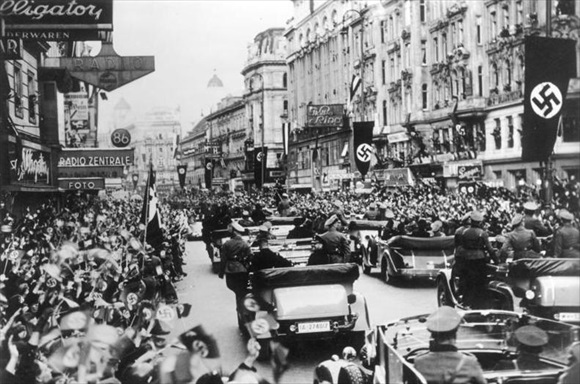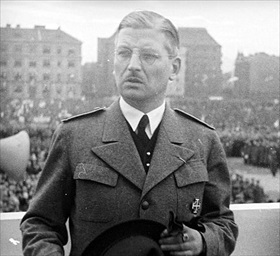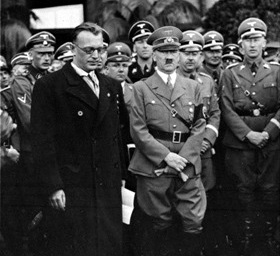HITLER, AUSTRIAN HEAD TO CONFER
Salzburg, Austria · February 11, 1938
On this date in 1938 Austrian Chancellor Kurt Schuschnigg arrived in Salzburg for a quick trip over the German border to confer with Adolf Hitler at his Bavarian Alps residence, the Berghof. An Austrian native, Hitler had been granted German citizenship in 1932. The following January the Nazi Party leader was appointed Chancellor of Germany. In 1934 Schuschnigg succeeded to the top post in Austria after Chancellor Engelbert Dollfuss had been murdered in a failed coup d’état by members of the Austrian Nazi Party, a party that was secretly funded by the German Foreign Office in Berlin. Chancellor Schuschnigg’s clandestine meeting with Hitler on February 12 was anything but pleasant, Hitler insulting the Austrian leader and raving at one point: “I have only to give an order and your ridiculous defenses will be blown to bits!” Hitler gave the Austrian chancellor a deadline of February 15 to resign in favor of Austrian Nazi Party leader Arthur Seyss-Inquart, whose party Dollfuss had banned, jailing many of its members. Once safely back in Austria, Schuschnigg worked against German machinations. He called for a March 13 nationwide plebiscite to demonstrate Austrian resolve against German coercion, political or otherwise, believing that Hitler would not risk an international incident. The day before the scheduled plebiscite German troops marched into Austria. Schuschnigg was arrested (he and his wife were eventually sent to Sachsenhausen, then Dachau concentration camps), and Austrian Nazi Party leader Seyss-Inquart named himself both chancellor and president of Austria, despite the refusal of the sitting president, Wilhelm Miklas, to resign his office. Hitler crossed the border shortly afterwards, welcomed by thunderous crowds, some celebratory scenes genuine, some staged. April 10 sham plebiscites in both countries showed 99 percent supported the Anschluss, or union with Germany. (British intelligence, on the other hand, estimated that not more than 35 percent of Austrian voters had cast their ballots in favor of Anschluss.) After the elections Austria became known as Ostmark, “the Eastern Region,” and was fully incorporated into Greater Germany (Grossdeutschland), a dream Hitler had laid out in his muddled, frightening blueprint, Mein Kampf (My Struggle), in 1925.
[amazon_carousel widget_type=”ASINList” width=”600″ height=”200″ title=”Recommended Reading” market_place=”US” shuffle_products=”False” show_border=”False” asin=”0520253833,1586177095,1929631421,014311610X,1616086084,0395925037,1929631618,0140133631,143919100X,0807853631″ /]
German-Austrian Anschluss, 1938
 |
Above: Hundreds of thousands of Austrians lined the streets as Hitler and his entourage made a triumphal entry into Austria’s capital, Vienna, on March 14, 1938.
 |  |
Left: Austrian chancellor (1934–1938) and Fatherland Front leader Kurt Schuschnigg at a party rally, 1936. Schuschnigg rejected Hitler’s Pan-German politics; instead, he focused on protecting Austria’s independence during a decade of political unrest in Central Europe. After the war and his release from German captivity, Schuschnigg emigrated to the U.S., where he taught political science at Saint Louis University in Missouri from 1948 to 1967. Schuschnigg returned to Austria where he died in 1977.
![]()
Right: Nazi Reich Governor Arthur Seyss-Inquart with Hitler in Vienna, 1938. During their February 1938 meeting at the Berghof, Hitler bullied Schuschnigg into appointing Austrian Nazi Party leader Seyss-Inquart to head Austria’s Ministry of Public Security, a post that gave Austrian Nazis full and unlimited control of their country’s police forces. With the assistance of Seyss-Inquart’s post-Anschluss puppet government, the Nazis quickly embarked on a campaign of repression and terror. Tens of thousands of Austrians, including Catholics, Social Democrats, Socialists, and Communists, were arrested and sent to concentration camps.
Hitler’s Entry into Austria, March and April 1938. Also clips of Hitler and Benito Mussolini in Nuremberg, Germany, September 1937
![]()

 History buffs, there is good news! The Daily Chronicles of World War II is now available as an ebook for $4.99 on Amazon.com. Containing a year’s worth of dated entries from this website, the ebook brings the story of this tumultuous era to life in a compelling, authoritative, and succinct manner. Featuring inventive navigation aids, the ebook enables readers to instantly move forward or backward by month and date to different dated entries. Simple and elegant! Click
History buffs, there is good news! The Daily Chronicles of World War II is now available as an ebook for $4.99 on Amazon.com. Containing a year’s worth of dated entries from this website, the ebook brings the story of this tumultuous era to life in a compelling, authoritative, and succinct manner. Featuring inventive navigation aids, the ebook enables readers to instantly move forward or backward by month and date to different dated entries. Simple and elegant! Click 











